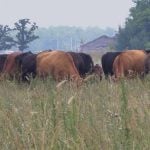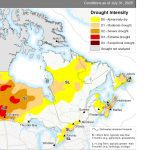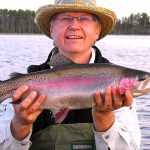Recent reports that the United States may lift border restrictions on Canadian cattle by next year had purebred cattle breeders cautiously optimistic at the recent Saskatoon Fall Fair.
“Whether it does (open) or not, I’m not going to hold my breath; it’s kind of a wait and see game,” said Heather Haydock of Matlock Stock Farms near Lloydminster, which showed cattle at the fair.
“I’m not going to believe it until it actually happens, until there’s a trailer load of purebred heifers or commercial heifers that are over 30 months (getting) across the border.”
Read Also

Alberta eases water access for riparian restoration
Alberta government removes requirement for temporary diversion licence to water plants up to 100 cubic metres per day for smaller riparian restoration projects
Recent news reports indicate the U.S. Department of Agriculture plans to propose lifting all remaining BSE-related restrictions on imports of Canadian cattle by next year. A rule is scheduled to be proposed in six to eight months.
Lori Cates, agriculture manager for Saskatoon Prairieland Park where the Fall Fair was held Nov. 16-19, said the outlook at the show was positive.
“There’s lots of buzz in the barn and everyone’s talking. There doesn’t seem to be that doom and gloom right now.”
Haydock said the border closure left a hole in her farm’s revenue. Matlock Stock Farms is a purebred Shorthorn and commercial Limousin operation that, before BSE, depended heavily on American cattle buyers.
“The biggest impact on us was we couldn’t sell breeding stock,” Haydock said.
Cattle older than 30 months have been prohibited from entering the U.S. since Canada’s first native case of BSE was discovered in 2003, leaving Canadian cattle breeders like Haydock with plenty of breeding stock and a closed major market.
Haydock said breeders could not afford to wait for the border to re-open.
“(The) Canadian cattle industry learned a very big lesson when the border closed and we were literally out of business because our major customer suddenly said, ‘I don’t want your cattle anymore.’ We didn’t know what to do.”
Haydock said her family survived the closure by exploring new avenues for their breeding stock.
“We really tried to reach out to the commercial cattlemen by switching our focus for the commercial herd.”
The family began exhibiting crossbred commercial Limousin Shorthorn heifers in local shows and Haydock said they hope to increase awareness of Shorthorn cattle in the commercial industry as a crossbreeding option.
“People that may not have thought of Shorthorns as a cross have now come around and said, ‘well wow, I didn’t realize Shorthorns were that good or that thick or that long.’ “
Haydock said the Canadian cattle industry should focus on rebuilding itself, rather than waiting for an American market to resurface.
“We hope it will happen, but if it doesn’t happen, we’re going to keep pushing our commercial cattle really hard and showing and advertising the commercial heifers and trying to get bull sales that way.”
She said the Fall Fair is a good place to sell breeding stock because commercial cattle producers who are looking for purebred bulls are exhibiting in the same facility.
“Coming here is a way of getting to the commercial cattlemen and showing them what we have to offer them and hopefully they’ll come back for a second look and you’ll see a cheque in your hand.”
Val Brown, a judge at the Fall Fair, said Canadian purebred breeders should be proud of their quality bloodlines.
“We would like to see some of that breeding stock going south because the U.S. has looked to our cattle to enhance their breeding programs.”
Even with the border closed, Haydock said American producers are contacting her farm looking for purebred cattle.
“I think it does look like we’ll see a big frenzy of U.S. cattlemen coming up here and buying a lot of females and taking them back down there.”
While Haydock is focusing on her Canadian customers, she admitted an open border would increase cash flow.
“We’re going to have purebred heifers go down there and make $2,000, $4,000.”
Haydock said many breeders at the fair feel the same way.
“I think the majority of cattlemen here are probably going to say, ‘well, if that opens that’s going to be great. If it doesn’t open, well, on to plan B and we’ll believe it when we see it.’ “
















